













Welcome to Part 2 of this case study! I'm still falling through this pipe, but I can feel the temperature changing, so we must be close to the end.













But before we pop out, I want to recap what happened in Part 1!



















In levels 1 and 2 we acquired the Tome of Gamification and the Trident of Motivation.











We learned how to effectively apply gamification to an experience, how Duolingo uses extrinsic rewards well, what Self-Determination Theory (SDT) is, and how to use Autonomy to give users intrinsic motivation.















Now we'll get into how Duolingo uses the extrinsic reward - daily streaks - to engage users and the upsides and downsides of that approach. Then we'll look at the third component of SDT, relatedness, and how to build good social experiences.





What makes good and bad gamification
5.
4.
✅
✅
3.
Designing for different playstyles
What are failure states?
How to improve social experiences using gamification
Downloadable Cheat Sheet 🎁
Case Study Overview













Here we go!
LEVEL 3

Level 3
DAILY STREAKS AND
FAIL STATES































































Whew, is it just me or did it just get hot in here?








































































But we won't let that get us down, our Trident will keep us motivated. We've already found two artifacts, let's keep that streak going!





































































Speaking of which, Duolingo relies heavily on daily streaks to keep their users engaged. You could say that all of Duo's eggs are in the daily streak basket!






































































So why have they done this? Well, it turns out that people absolutely love keeping a streak alive! Many users have streaks hundreds, or even thousands of days long.








































































Part of the reason is that Duolingo does a lot to make daily streaks feel important.








































































Once you complete your first lesson each day, Duolingo gives you a fun animation and lets you know how many days your streak has reached so far.






































































Your streak is shown to other people who see your profile as a badge of honor and social status within the community.

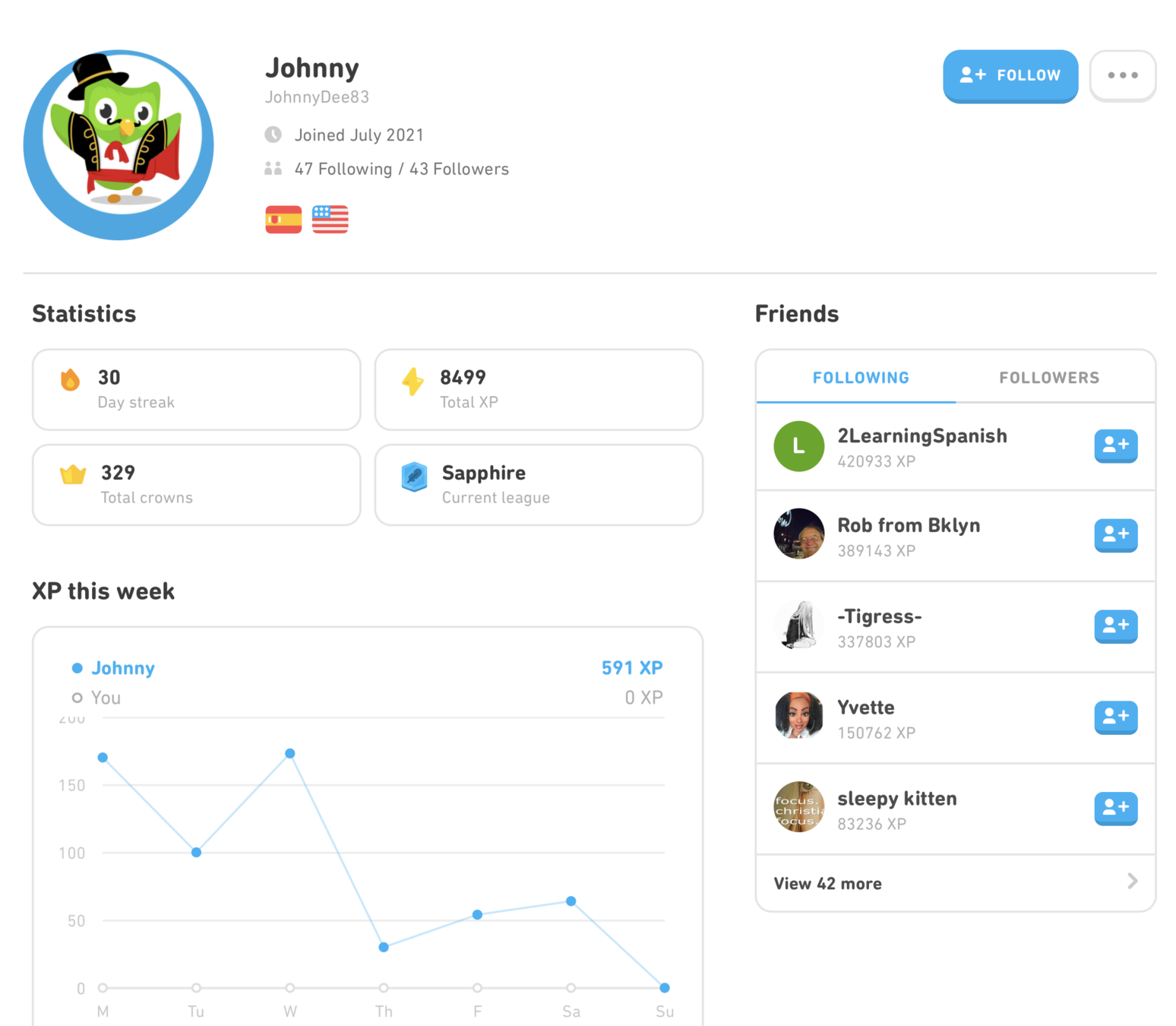



































































And Duolingo really celebrates daily streak milestones whenever they can.

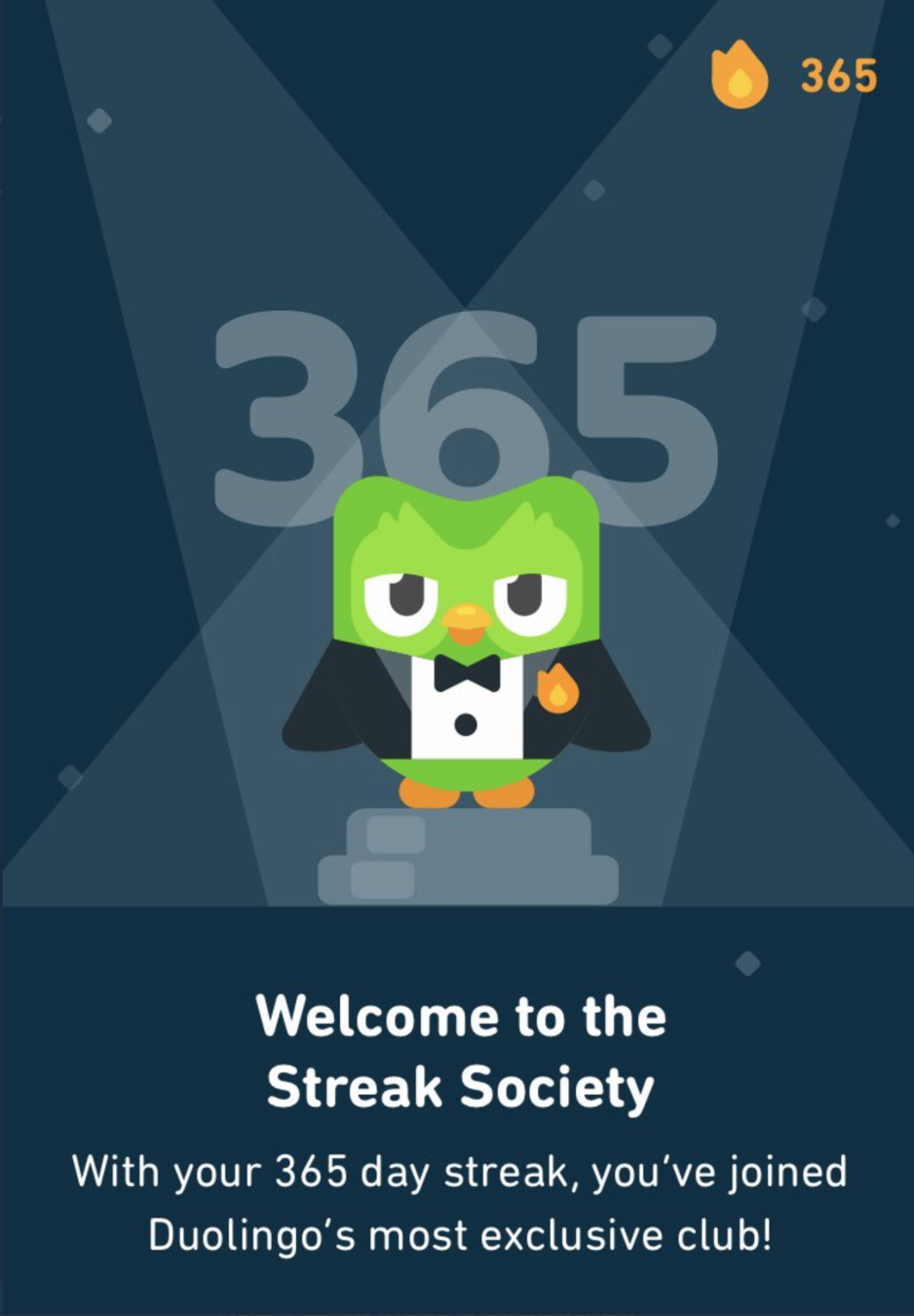




































































But what happens when you go on vacation and forget a day, or lose your internet connection at the wrong moment?




































































Failure! Or at least that's how it feels.

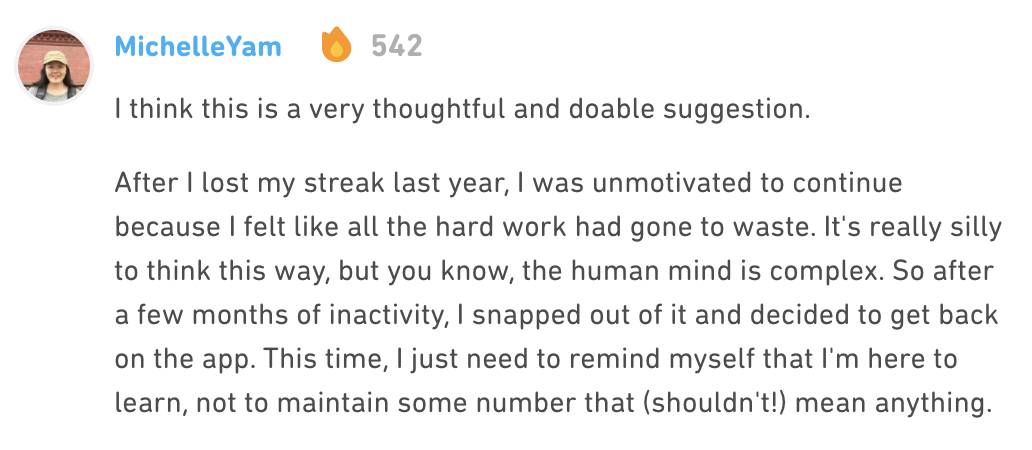






































































Losing a streak that you've spent days, weeks, or months building can be extremely demotivating. This is one of the big downsides of building your experience around extrinsic rewards. Comments in Duolingo's own forums show how widespread this problem is.








































































We can see the downside of streaks elsewhere as well. In 2016, GitHub, a coding repository for software developers, removed its own daily streak element without warning. This provided a really nice natural experiment.

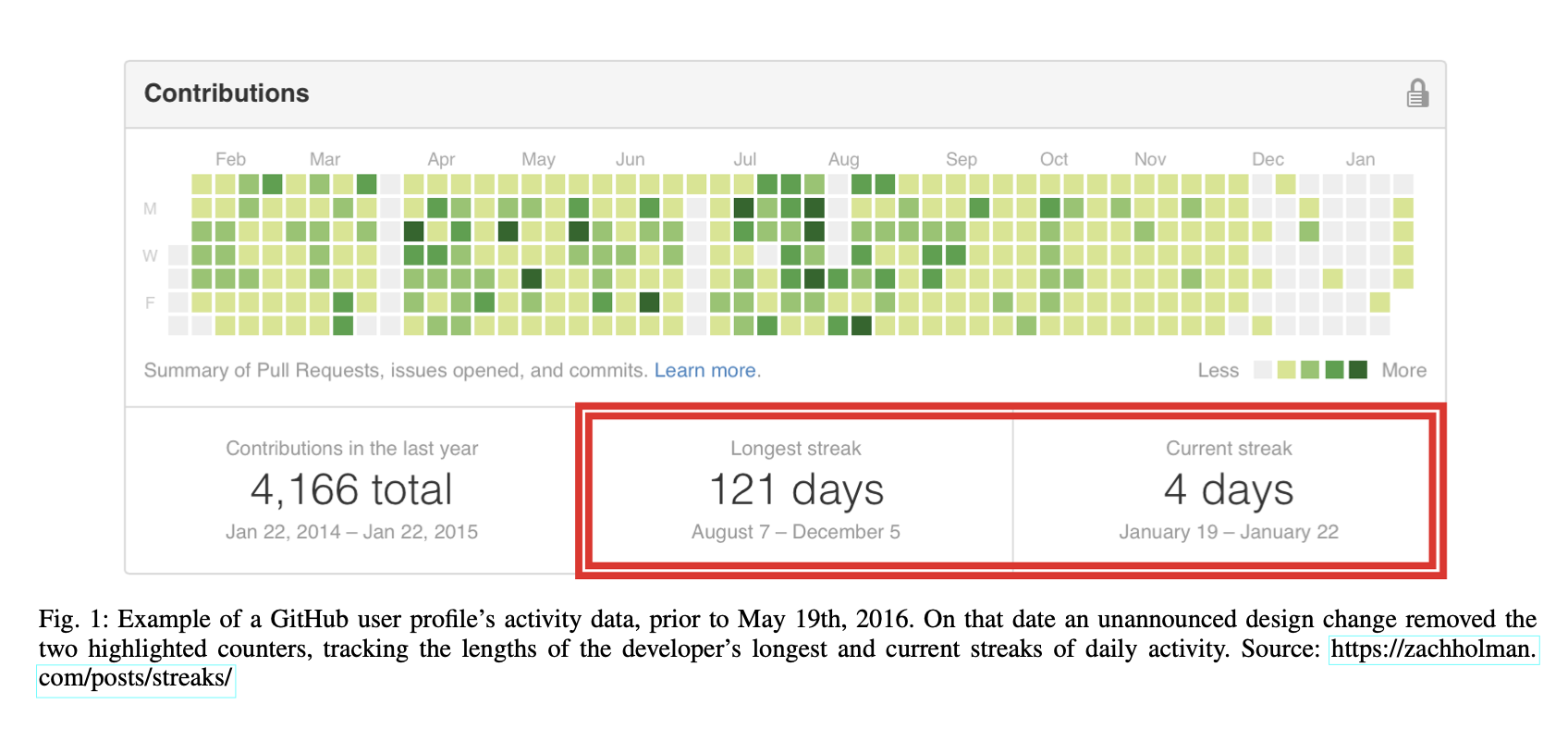



































































Immediately following the removal of visible streaks on their platform, GitHub saw it's largest decrease in engagement in over 3 years.





































































Even Duolingo's own former VP of Marketing, Gina Gotthilf, wasn't immune to the demotivating power of streaks after losing one of her own after 80 days.



From Advertising Influencers podcast



































































Although the daily streak has no impact on how much you've learned, it still feels like you've wasted your time after losing all that streak progress.





































































Breaking a streak is what's called a fail state or failure state in game design. A classic example is getting a game over screen for failing to complete a level in a game.





































































But what exactly is a fail state? Essentially a fail state is when a player does not complete a set objective and receives some punishment as a consequence.

Fail States
fail to meet objective
receive punishment



































































Fail states serve a purpose in games, to enhance the feeling of satisfaction once the game's challenge is accomplished.

Fail States
fail to meet objective
receive punishment



































































In a study by Juul (2009), players who finished a game after having died several times rated the game as more enjoyable than those who completed the same game without encountering any fail states.

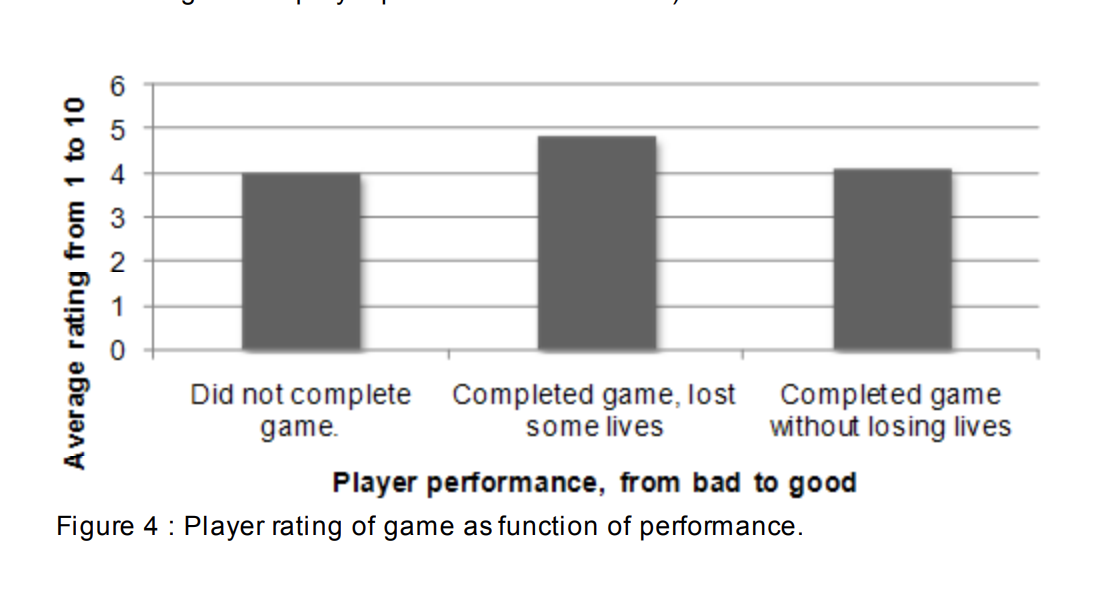



































































But, as we've seen with daily streaks, in a user design and gamification context, fail states need to be carefully considered. Duolingo has some minor fail states that serve a good purpose.

Fail States
fail to meet objective
receive punishment



































































If you make a mistake in one of your lessons, you'll lose a heart, and losing too many hearts means having to restart the lesson. This ensures that the user really did learn what they were meant to learn before they can progress.






































































But significant fail states may only serve to demotivate your users. They shouldn't ever feel like their effort and progress has been completely lost, or you will lose them too!






































































Because daily streaks get reset to 0 when they are broken, Duolingo makes breaking a streak feel excruciating. Since you likely conflate the streak with your language habit, losing the streak can feel like your habit is lost and almost like you haven't learned anything at all!






































































Duolingo have priced removing this painful experience at around $5, in some instances up to $10. They effectively take the streak hostage and you'll have to pay to recover it (unless you had enough streak freezes). Maybe not the best long-term monetizing strategy?






































































So how can you build gratifying fail states into your experience without demotivating your users?




































































The first tip is to make fail states dependent on the core of your experience, the part that drives a user's intrinsic motivation to continue.

Tips for effective fail states
1. Tie fail state to core experience



































































As we discussed earlier, making a mistake during a Duolingo lesson results in losing a heart. This fail state helps motivate the user to make fewer mistakes, and therefore to have a better learning experience.

Tips for effective fail states
1. Tie fail state to core experience



































































In contrast, losing a daily streak count feels arbitrary and disconnected from the learning experience.




































































The social media platform Snapchat also has a daily streak element. Snapchat users will send black screens or other impersonal pictures to their friends just to maintain a streak.


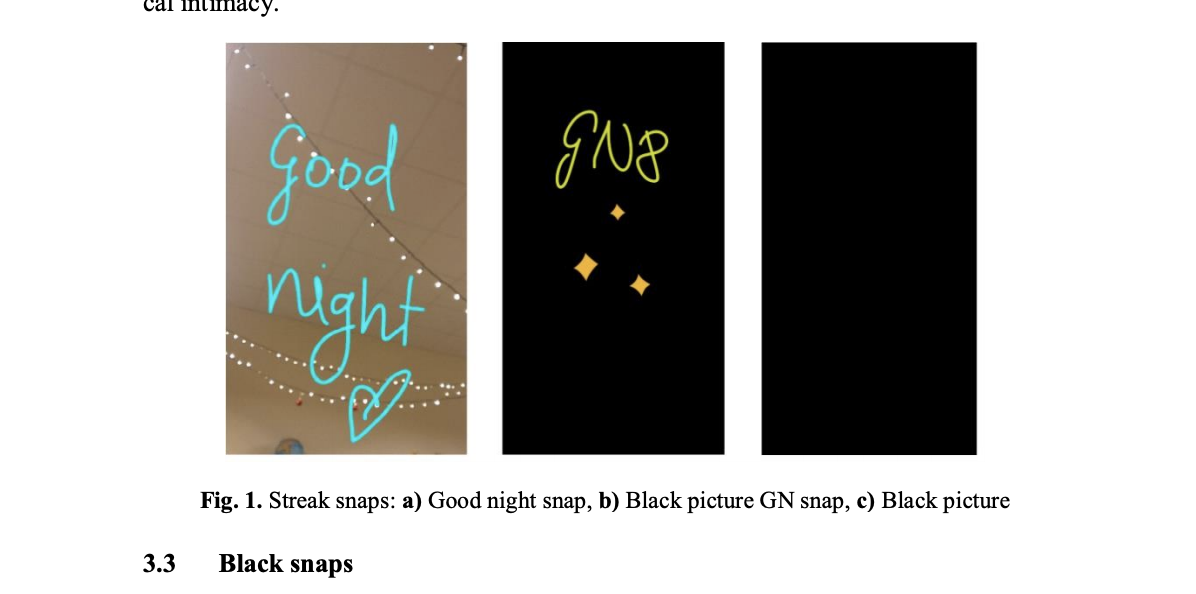



































































This behavior completely misses the point of the platform, to send pictures to your friends to form a personal connection. And yet, to maintain the extrinsic reward of the daily streak, users will send impersonal photos every day.






































































A similar behavior happens with Duolingo, users will maintain long streaks by repeating early lessons that they know they can complete with ease just to avoid losing their streak!

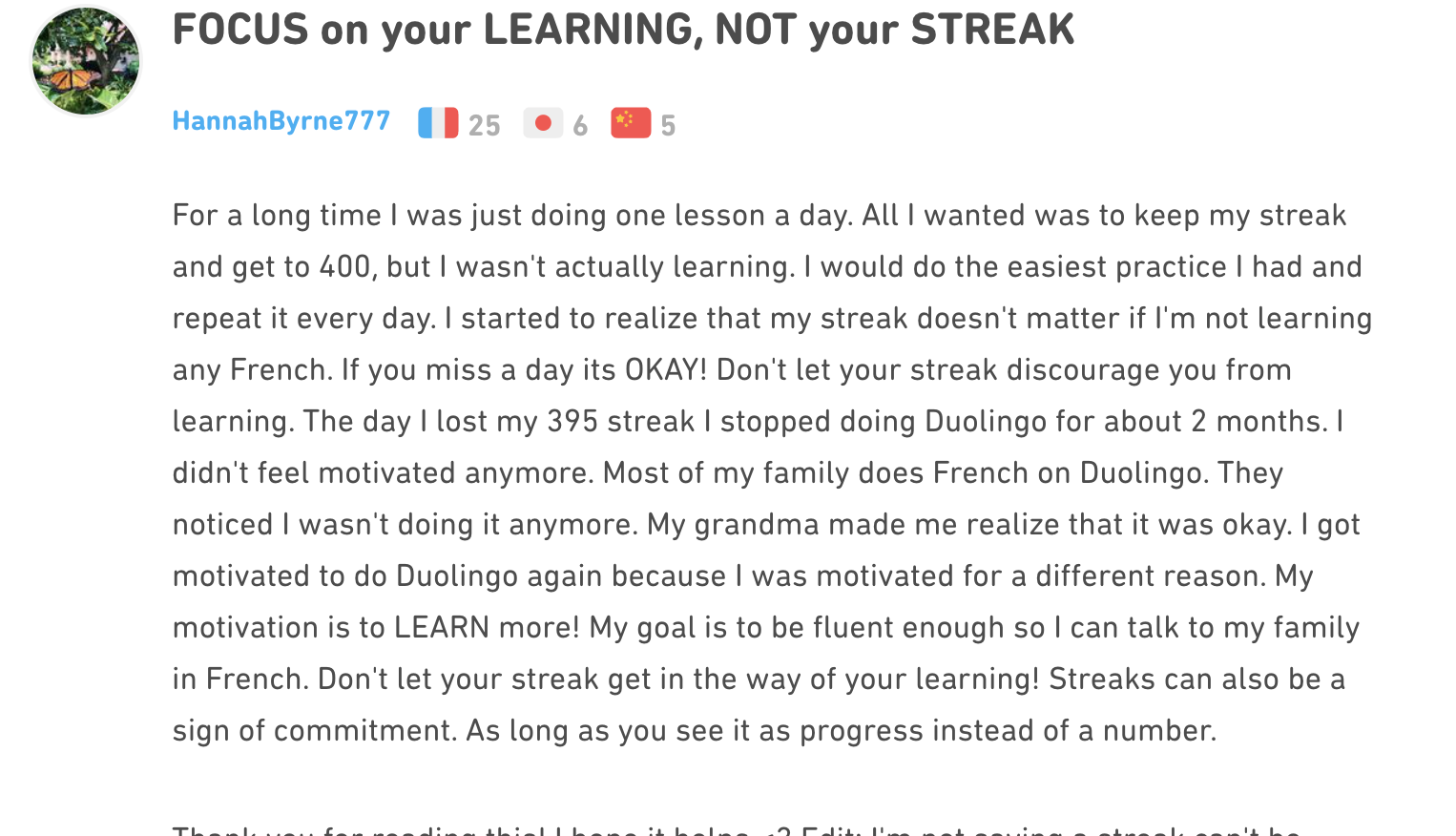
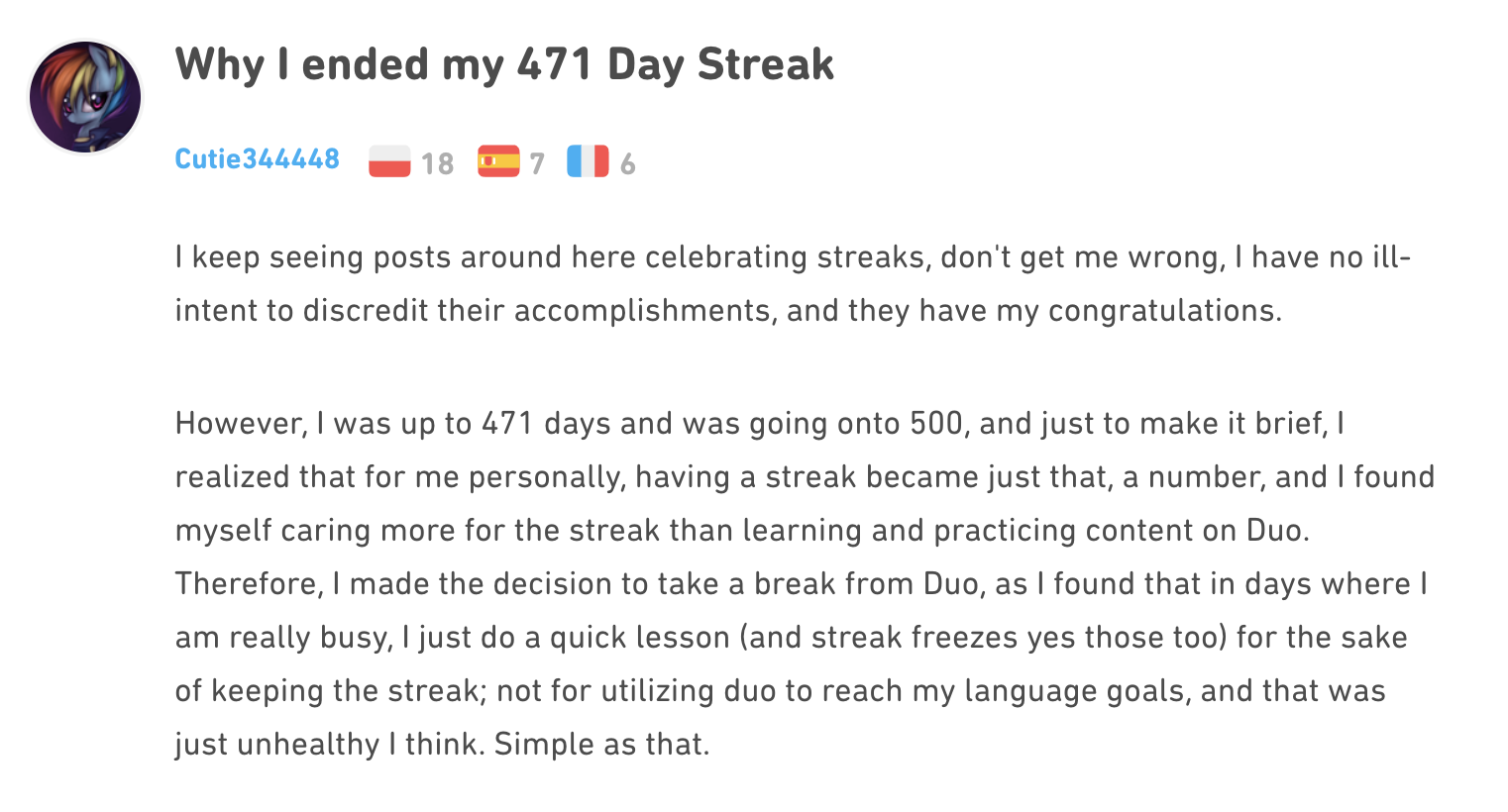




































































The second tip is to soften your fail states by providing extra support to those who fail.

Tips for effective fail states
1. Tie fail state to core experience
2. Make it easy to recover from failure



































































In the racing game Mario Kart, racers in last place are given better items that help them to get back in the race.





































































Providing support to those players that aren't doing as well can help them feel like they still have a chance to improve.





































































Failing a Duolingo streak offers little support, though they do have a few mechanisms.




































































For example, you can buy a "Streak Freeze" that lets you miss a single day without losing your streak, or an amulet that lets you skip the weekend without penalty. But these solutions are bandaids.

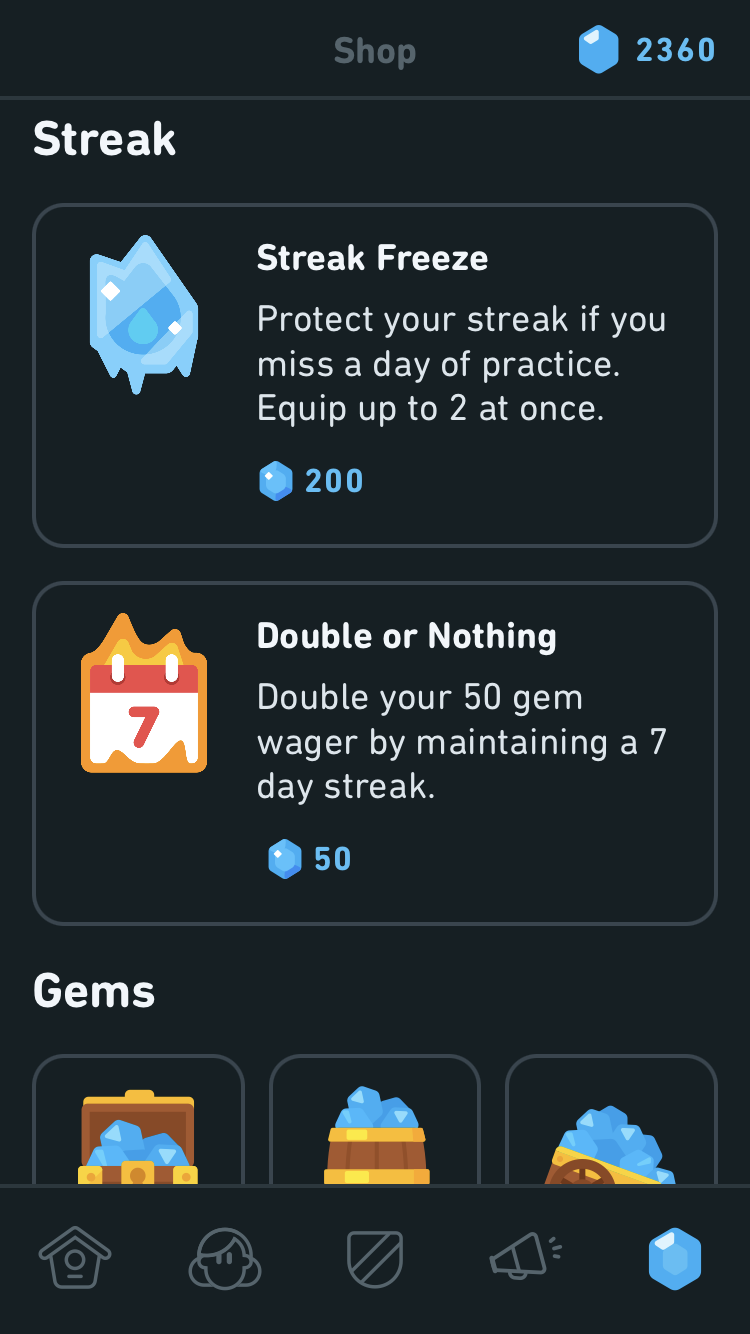




































































A better method could be to slowly reduce a user's streak for each day they've missed, or Duolingo could entice users to return to the app by giving them a percentage of their streak back for completing a new lesson, other ways of recovering the streak.

10
9



































































The key to softening fail states is rather than giving harsh punishments to users for leaving your platform, reward them for returning.

Tips for effective fail states
1. Tie fail state to core experience
2. Support those that fail



































































Speaking of which, I feel a reward coming on!




































































Something is coming out of the fire! Let's grab it.


































































Our third artifact!

RING of FAILURE ACQUIRED


































































Huh? This ring is cool to the touch. Isn't metal supposed to retain lots of heat? No matter, it's my precious now...



































































Woah, that was weird... Do you think I should be concerned about that? I'm sure it's nothing.




































































Anyway, these two tips should help you avoid most problems with fail states in user design. But if you're interested to learn more about different kinds of fail states and how they're used in games, I recommend checking out this game design video!








































































Now that we've explored fail states, let's return back to the last SDT component, relatedness, to see how Duolingo can make better social experiences!













































Thank god, an exit! I've had enough of this heat. Let's get out of here!









LEVEL 4
Level 4
MAKING BETTER SOCIAL EXPERIENCES








































Oh, hi there everyone! What are you all doing here together?









































This is a jungle animal gaming club. We were just dissscusssing our different playssstylesss.









































Oh, really? Have you heard about Self-Determination Theory? I think it could be helpful for you!









































I've been trying to explain why i don't enjoy solitaire, but I just can't get my feathers on it. Maybe this theory can help, please go on.










































Well, SDT says intrinsic motivation comes from 3 innate needs, competence, autonomy, and relatedness. The third SDT component, relatedness, might be the reason you're not too keen on solitaire.
Self-Determination
Theory
Competence
Autonomy
Relatedness
Motivation






































Relatedness covers one of the strongest mechanisms of intrinsic motivation out there, connecting with others.





Self-Determination
Theory
Competence
Autonomy
Relatedness
Motivation






































That connection can manifest through things like social recognition of accomplishments and experiences, to simply interaction with like-minded people, friends, and family.






fun, shared experiences
comparing similar people
allowing supportive messages
THE NEED FOR SOCIAL CONNECTION
Relatedness




































I have to say, you're doing a great job explaining this. You've clearly put a lot of thought and effort into your speech and it shows.









































I appreciate your support. You're a quick learner it seems!









































Unfortunately, I find Duolingo (and solitaire) somewhat lacking in relatedness!









































Duolingo has two main social features. The first is the classic gamification element, leaderboards. And the second is their "Friends" feature.









































Duolingo's leaderboards are done reasonably very well. Each week users are placed into a competitive leaderboard with 20-30 other people, usually strangers.






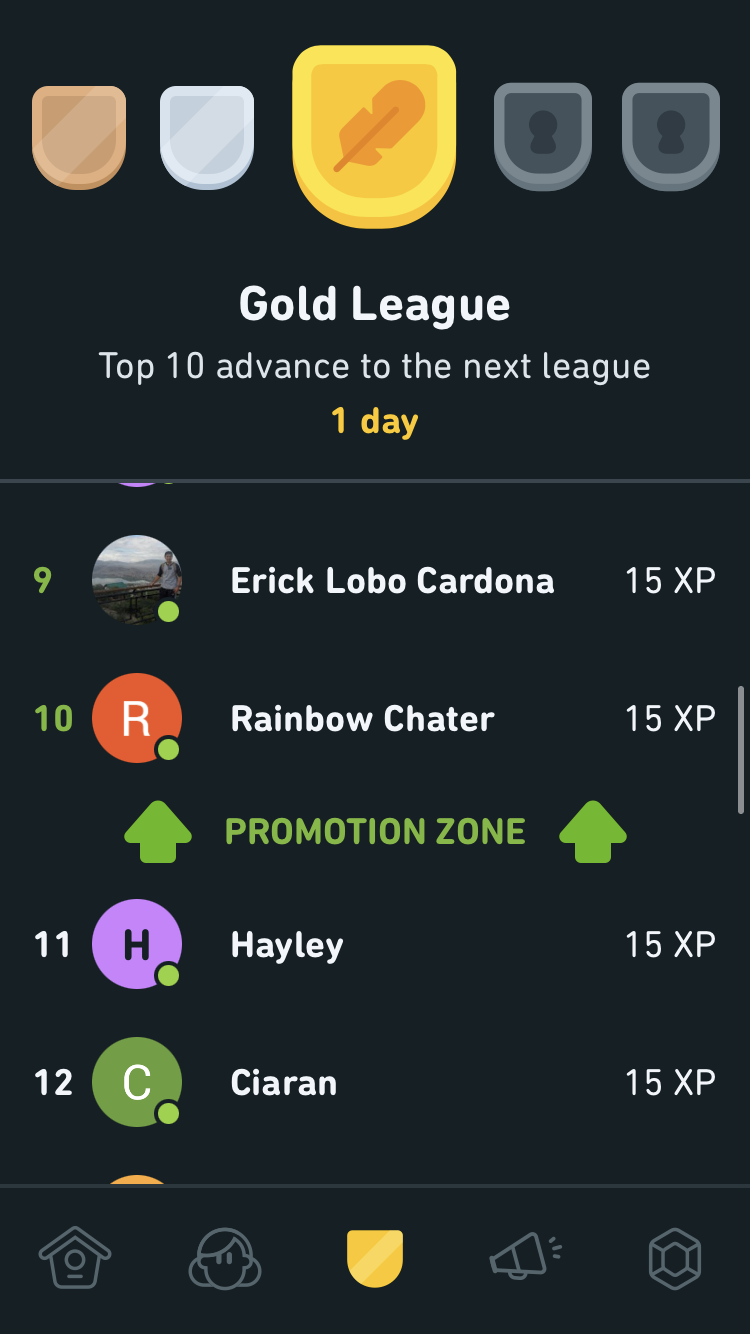




































The top few users with the most experience points that week are promoted to a leaderboard of a higher rank for the next week, and the lowest few are placed into a lower ranking leaderboard.













































This ensures that you are always competing with people at your level, and that you never feel out of reach of the next higher rank, while also encouraging you not to fall too far behind.











































Duolingo's "Friends" feature is a little less effective.











































This feature sort of allows you to connect both with people you know and with other people you see on the platform.











































The problem is that the feature ends there. You can connect with other people but you can't interact with them in Duolingo's app.











































Besides the popularity factor of collecting friends, which is more of an extrinsic reward, Duolingo misses opportunities to use friends as intrinsic motivators in the language learning process.











































They could allow friends to support one another in their goal of learning a language. For instance, being able to send supportive messages or allowing friends to challenge and compete with one another.









































Duolingo could also implement social commitment devices from behavioral science like accountability partners. You partner up with a friend and you get a nice experience boost, but only if you both complete a certain number of new lessons.









































As you can see, not utilizing relatedness is a real missed opportunity!









































This is fascinating stuff! I want to give you something for enlightening me to the power of friendship. This is my best friend, treat him well.










































The fourth artifact! Thank you!




acorn of friendship ACQUIRED








































Wish I could stay longer, but it's time to wrap things up. Thanks again! Hey, that window looks familiar...





LEVEL 5
Level 5
Epilogue




We've made it to the end, and collected all four mystical artifacts!












The Tome of Gamification revealed principles for applying effective gamification, and showed us how extrinsic motivators can be used to increase motivation.












We received the Trident of Motivation for learning about Self-Determination Theory and how Autonomy could be used to supply intrinsic motivation to an experience.












The Ring of Failure appeared after we mastered fail states and how they apply to Duolingo's daily streaks.












And lastly, the Acorn of Friendship was bequeathed to us for uncovering the power of relatedness!












Combine, they unlock your downloadable Cheat Sheet for this case study! 🎉








Cheat sheet






Thank you for taking this gamification journey with me! See you later!






What makes good and bad gamification
4.
1.
2.
3.
Designing for different playstyles
What are failure states?
How to improve social experiences using gamification
Case Study Overview






Case study made by
Alex Moog

Samuel Salzer
Alex has an MSc in Behaviour Change from University College London, is an alumnus of The Center for Advanced Hindsight at Duke University, and runs the YouTube channel Behavioral Science Toolkit. He enjoys learning about and spreading behavioral science knowledge, and loves games in all their many forms.
Samuel you probably know by now, he's the founder of Habit Weekly, author and a leading behavioural strategist and habit expert, working with helping value-driven organizations to apply behavioral science.







But now I have a little bit of a bonus for you for sticking around!









At the beginning we talked about how good gamification requires a purpose, and that Duolingo's purpose is getting their users to come back and complete one or two lessons every single day.









So let's now explore whether that is really the best goal for Duolingo to have, especially with something as complicated as learning a language!





Bonus level!
USING THE RIGHT METRICS FOR SUCCESS




Determining the right metrics for success is hugely important in running a good business. Let's take a look at Duolingo's success metric, and see if we can come up with a better one!









Daily Active Users (DAUs) drive Duolingo's decision making process.









They tell their users that learning a language takes daily practice, and that this is why they put such an emphasis on counting daily streaks.









Conveniently, more DAUs for Duolingo means more revenue.









If they can get people to come back habitually every day, that means more advertisements, more premium subscriptions, and more sales of streak freezes and weekend amulets.









This isn't bad in-and-of itself. Businesses need revenue to survive, and Duolingo has mastered its business model.









But this begs the question, is logging into Duolingo for 5-10 minutes each day the best way to learn a language? And has Duolingo's focus on DAUs lead them toward any bad design choices?









As we talked about earlier, different people have different playstyles. But Duolingo tries to focus everyone into the same learning pattern, leaving little room for personalizing your learning experience.









The problem with using DAUs as a success metric is that it removes language learning from the equation! It doesn't matter if you're actually learning new words and grammar as long as you return to the app









In fact, you could return and do the same lesson every day and Duolingo would count that as a success, and your streak would keep going too.









For users truly interested in learning, this presents a problem.









Should I use Duolingo, which is a fun, engaging app, or should I use a different app that's more focused on language attainment, or even just go to an in-person class instead?









Duolingo's DAU success metric has led them to the problems we discussed earlier; the double-edged sword of daily streaks, their over-reliance on extrinsic motivators, and the lack of choice they offer.









If instead Duolingo focuses on other more intrinsic success metrics, such as the number of words a user learns, or how long it takes them to reach a certain level of proficiency, intrinsic motivation would be reflected into their design choices.









If instead Duolingo focuses on other more intrinsic success metrics, such as the number of words a user learns, or how long it takes them to reach a certain level of proficiency, intrinsic motivation would be reflected into their design choices.







